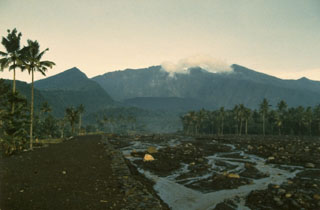Report on Galunggung (Indonesia) — November 1982
Scientific Event Alert Network Bulletin, vol. 7, no. 11 (November 1982)
Managing Editor: Lindsay McClelland.
Galunggung (Indonesia) Explosion and lahars
Please cite this report as:
Global Volcanism Program, 1982. Report on Galunggung (Indonesia) (McClelland, L., ed.). Scientific Event Alert Network Bulletin, 7:11. Smithsonian Institution. https://doi.org/10.5479/si.GVP.SEAN198211-263140
Galunggung
Indonesia
7.25°S, 108.058°E; summit elev. 2168 m
All times are local (unless otherwise noted)
Press sources reported that an explosion on 3 December ejected ash and incandescent material. Strong winds blew fine ash to Garut. Within an hour, lahars were flowing down two river valleys. Heavy clouds that cover Java for much of the day during the rainy season prevented satellite observation of the eruption cloud. No explosions had been reported since 4 November and the 3 December explosion was said to follow "a period of relative calm."
Since the eruption began 5 April, ~ 40 x 106 m3 of tephra and mud have accumulated on the flanks of the volcano. Monsoon rains threaten to remobilize this material and form destructive lahars. In the primary danger zone, residents have been given 40,000 plastic bags, which are to be filled with sand and used as a protection against flooding. Authorities have warned residents of the city of Tasikmalaya of the danger of lahars.
Geological Summary. The forested slopes of Galunggung in western Java SE of Bandung are cut by a 2-km-wide collapse scarp open towards the ESE. The "Ten Thousand Hills of Tasikmalaya" dotting the plain below the volcano are debris-avalanche hummocks from the collapse about 4,200 years ago. An eruption in 1822 produced pyroclastic flows and lahars that killed over 4,000 people. A series of major explosive eruptions starting in April 1982 destroyed a number of villages, killed as many as 30 people, and forced over 60,000 to evacuate. Pyroclastic flows and heavy widespread ash caused significant damage. A large passenger jet that encountered the ash plume on 24 June lost power to all four engines but managed to land safely in Jakarta. The 1982 activity destroyed a 1918 dome and formed the Warirang crater, almost as wide as the valley, about 2 km down from the summit.
Information Contacts: D. Haller, NOAA; AFP; Sinar Harapan, Jakarta.

